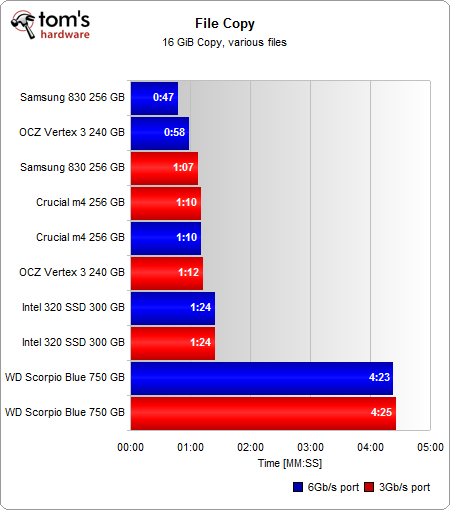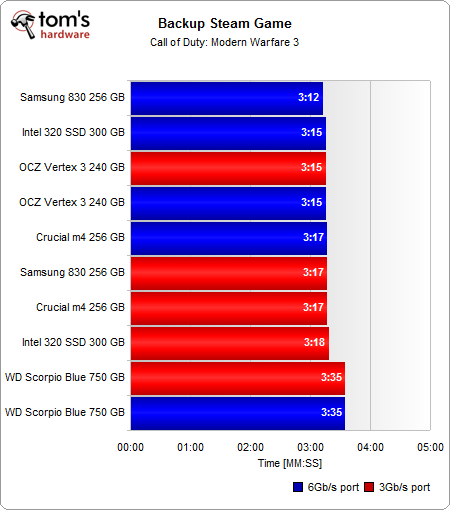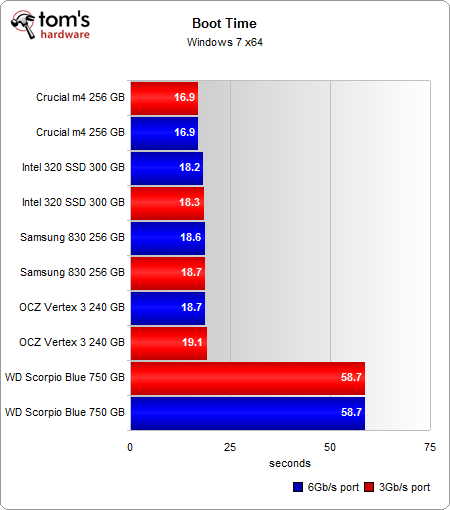Upgrade Advice: Does Your Fast SSD Really Need SATA 6Gb/s?
Real-World Tests
After receiving a number of requests for more real-world testing, we're moving in that direction. Our trace-based benchmarking gives you a holistic performance picture. And the more specific random/sequential read/write measurements drill down into more targeted workload profiles.
However, we still haven't answered our original question in a way that makes the decision to use your new SSD on an old platform or buy something new any easier. Does our testing indicate the need for 6 Gb/s connectivity or not?
We know that most of our real-world tests see queue depths of one, and involve a mixture of compressible and incompressible data. In this particular test, we're transferring 11 GiB worth of video clips (which, of course, you can't really smash down any more than the H.264 compression standard), along with a slew of smaller files that are compressible.
Here's where things get interesting. Because of this workload's profile, there's frankly very little improvement to realize in jumping from SATA 3Gb/s to SATA 6Gb/s. Crucial's m4, for example, performs exactly the same at both data rates.
Yes, the Samsung and OCZ drives are able to present quantifiable gains. However, the real story here is a comparison to even the slowest SSD, Intel's SSD 320, and Western Digital's Scorpio Blue, a drive you might have installed in a notebook. The reality of the situation is that this battle isn't between the fastest and slowest SSDs, it's a matter of comparing hard drives to solid-state storage.
Backing up a game using Steam incorporates a mix of incompressible and compressible sequential writes, along with a sizable number of random write operations. This task also involves a good deal of host processing as individual files are packed into archives. The result is that there's not much difference between SATA 3Gb/s and 6Gb/s, or even between the SSDs and hard drive, since storage surprisingly isn't a big bottleneck.
Of course, we know that storage performance is only one determinant of benchmark results. Remember our office productivity analysis? In nearly 30 minutes of antivirus scanning, our SSD was only busy for 281 seconds. In essence, the task wasn't taxing enough to demonstrate an SSD's benefit.
Get Tom's Hardware's best news and in-depth reviews, straight to your inbox.
In order to push the test harder, you have to add concurrent operations. For example, we can still transfer files to and from the SSDs while the backup operation executes with minimal penalty. On a hard drive, however, the same multi-tasked workload slows both actions to a crawl.
Measuring boot time is one of the best examples of how an SSD excels. You get a mix of random and sequential reads, along with some write operations attributable to logging. Queue depths during Windows boot can easily exceed four, as the operating system accesses multiple files in quick succession or at the same time.
The differences between the SSDs are again very minor, while the hard drive drags. Don't expect SATA 6Gb/s to buy you any additional speed in this metric, though.
Current page: Real-World Tests
Prev Page SandForce: Performance With Incompressible Data Next Page Buy The SSD You Can Afford, Not The Fastest One-
compton Buying the best drive rather than the perceived fastest is good advice. I have fast drives and slow drives, but I prize the reliable ones. The good news is that there are drives which are both fast and reliable, so don't buy a drive just because of its Vantage score or simply because of the speed with which it handles 0-fill data.Reply -
compton Which FW is the 830 using? The Test Setup and Benchmarks page lists it as CXM0. There are currently 3 FWs, CXM01,02,03]B1Q. The page simply lists CXM0.Reply -
phamhlam Crucial m4, Samsung 830, and Intel 320 are all good drives. 128GB drives go for $180. They are the best value.Reply
I find it interesting that SATA 3 doesn't make a difference in file copy. Most SATA 3 drives cost the same as a SATA 2 so no need to save a few dollars. -
SteelCity1981 So basiucly what this is saying is even thought SATA 3 looks impressive on paper, when it comes to actual real world results it's really not any faster than SATA 2 in performaning everyday real world task.Reply -
dark_knight33 I think I wrote you an email asking for this article when I was looking to buy my SSD a few weeks/months ago. Even though your article came after I purchased mine, thanks for addressing it. I'm rocking a Vertex III 240GB on my Sata II x58 MB and I don't regret it one bit.Reply -
a4mula I can say this. I'm running 2x OCZ Solid first gen SSDs off SATA 3Gb/s ICH10R. When new they benched at about 300/100 sequential read/write. Compared to current generation drives this is pretty slow. When researching my current build I asked a friend that just put together a rig with a 64GB M4 on Intel 6Gb/s if I could give it a spin. While his machine boots faster w/o a doubt, I attest most of this to the RAID verification I face when I boot. Inside Win7 I couldn't tell a difference at all. While I'm sure his system is faster, it just wasn't obvious or noticeable in my opinion.Reply -
sincreator What about quality? Is there any way to stress them till they start to fail? It just seems that if there isn't much difference in the drives in real world applications, then the next logical thing a buyer would want to know would be how much average data particuar drives can read/write before a failure. Like actual stress testing in a controlled environment. Come on Tom's, don't you want to destroy a few perfectly good SSD's? lol. These are things i would like to know more than anything else so I could make a very informed decision before a purchase.Reply
I asked before but no one answered. Anyway here goes... If SSD's are supposed to be more reliable than spinning drives, why are most warranties for 3 years instead of the usual 5 years on high end conventional spinning drives? It seems like the companies are not to confident in their products to me, and that's why I ask this question and the one that preceded it. It would be nice to get some honest answers...... -
compton sincreatorWhat about quality? Is there any way to stress them till they start to fail? It just seems that if there isn't much difference in the drives in real world applications, then the next logical thing a buyer would want to know would be how much average data particuar drives can read/write before a failure. Like actual stress testing in a controlled environment. Come on Tom's, don't you want to destroy a few perfectly good SSD's? lol. These are things i would like to know more than anything else so I could make a very informed decision before a purchase. I asked before but no one answered. Anyway here goes... If SSD's are supposed to be more reliable than spinning drives, why are most warranties for 3 years instead of the usual 5 years on high end conventional spinning drives? It seems like the companies are not to confident in their products to me, and that's why I ask this question and the one that preceded it. It would be nice to get some honest answers......Reply
Well, the warranties are mostly 3 years, but some drives like Intel's 320s and Plextor's M3S drives do have 5 years of coverage.
As for stress testing... well... some have taken this matter in their own hands to answer that very question. So far, it's far more than anyone could imagine. And for complex reasons, a drive only writing 10GB might not wear out it's NAND in over a century. A drive's endurance is typically way underestimated. No one is going to wear out any 3xnm or 2xnm NAND in 5 years, except in the most extreme cases. Most drives die from firmware problems, or physical damage to the PCB or components, or some other unknown phenomenon. Only the factory could do a proper autopsy, and since the FW, FTL, controller, etc. are usually trade secrets or covered under NDA, no one in the know is going to volunteer.
There is an SSD endurance thread on the XtremeSystems forum:
http://www.xtremesystems.org/forums/showthread.php?271063-SSD-Write-Endurance-25nm-Vs-34nm/page1
-
heezdeadjim You probably aren't going to see much of a difference in speed while on the desktop from one SSD to another. It's when loading programs and game levels that you might see a real difference in.Reply
I know when I first got my 1st gen OCZ Vertex nearly when it first came out, I was always the first person on the map for Counter Strike. While other players were still loading the level, I would rush in from the side and lob a grenade and take a few people out because they didn't think anyone could get there so fast (now with more people with SSD's, it's not quite so funny anymore).
I do appreciate being able to open PS CS5 in less than 2 seconds (for quick photo re-edits) and opening Premiere a lot faster too. Transferring large RAW photo folders (think 50+GBs total) to and from backup HDD's, I could use the extra MB's from these new 6Gb/s versions.
-
cmcghee358 I've read this article entirely too many times. Except this time it looks much better than the version I saw. Good job Mr. Angelini!Reply


